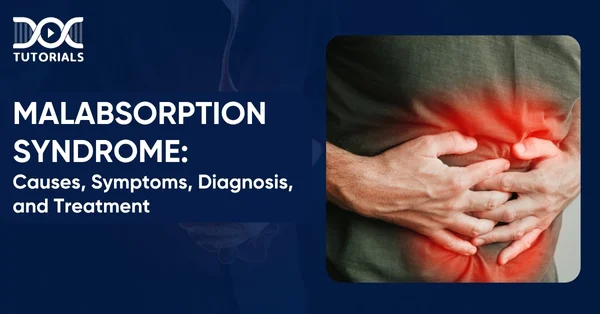Malabsorption Syndrome: Causes, Symptoms, Diagnosis, and Treatment

Malabsorption syndrome is a complicated digestive condition that interrupts your body’s capacity to absorb nutrients from food. It can lead to several health issues, ranging from minor discomfort to severe deficiencies, if not addressed in time. Although several factors can contribute to this condition, the primary cause of malabsorption syndrome is damage to the mucous lining in your small intestine.
If you are an NEET-PG aspirant, you must have a clear idea of malabsorption syndrome to cover your syllabus. Here’s more on its causes, symptoms, diagnosis, and treatment!
What is Malabsorption Syndrome?
Disorders that affect the body’s ability to absorb nutrients from the food you eat are termed malabsorption syndrome. Individuals with this syndrome experience malnutrition and indigestion despite taking sufficient nutrients due to the inability of nutrient absorption.
Digestion is usually a three-step procedure: breakdown, absorption, and excretion. The first step is to break down the food into tiny pieces. The second is absorbing the nutrients from your food. The third step is to eliminate the waste after absorbing the nutrients from your food.
Issues in the digestive system may be due to problems in any of these digestion steps. The second stage includes malabsorption problems. These include a variety of gastrointestinal disorders that affect your digestive tract, as well as some food intolerances caused by deficiencies in certain enzymes.
What are the Causes of Malabsorption Syndrome?
Malabsorption syndrome arises from a wide range of causes that disrupt the body’s ability to absorb nutrients effectively. Common causes include the following:
- Damage to the intestinal lining from infections
- Inflammation
- Trauma
- Surgery
- Chronic diseases like coeliac disease, Crohn’s disease, chronic pancreatitis, and cystic fibrosis
Prolonged antibiotic use, certain medications, and radiation therapy can also injure the intestine and impair absorption. Additionally, some individuals are born with congenital abnormalities such as biliary atresia, while others may develop enzyme deficiencies like lactose intolerance.
Rare conditions include short bowel syndrome, where part of the small intestine is missing or removed. Infections such as tropical sprue and Whipple’s disease can also cause malabsorption.
Diseases of the liver, gallbladder, or pancreas and parasitic infections are notable contributors. Ultimately, malabsorption syndrome can result from any factor that interferes with normal digestion, enzyme activity, or the structural integrity of the gut.
What are the Risk Factors of Malabsorption Syndrome?
Here are some of the risk factors of malabsorption syndrome:
- Drinking excessive amounts of alcohol
- Individuals who have a family history of malabsorption or cystic fibrosis
- Those who have undergone intestinal surgery
- Taking medicines that include mineral oil, laxatives, etc.
- Travelling to India, the Caribbean, or parts of Southeast Asia
What are the Symptoms of Malabsorption Syndrome?
Here are some of the common malabsorption symptoms:
- Abdominal pain and discomfort
- Abdominal distension and bloating
- Excessive gas
- Nausea and vomiting
- Chronic diarrhoea
- Steatorrhea (bulky, pale, greasy, foul-smelling stools that may float or stick to the toilet bowl)
- Unintentional weight loss
- Muscle wasting
- Frequent infections
- Easy bruising
- Dry skin, skin lesions
- Dry hair and hair loss
- Dehydration
- Oedema (swelling due to fluid retention)
- Anaemia (weakness, lightheadedness, paleness)
- Irritability, apathy, and fatigue
- Amenorrhea (missed periods) in women
- Growth delays or failure to thrive in children
- Night blindness (vitamin A deficiency)
- Bone pain or weak bones (vitamin D deficiency)
- Bleeding gums, nosebleeds (vitamin K deficiency)
- Sore, red tongue (vitamin B12 deficiency)
These symptoms may vary depending on which nutrients are not being absorbed properly.
How to Diagnose Malabsorption Syndrome?
Here are some of the diagnostic methods to detect malabsorption syndrome:
- Stool Test
This test helps check the amount of fat in your stool. Excess fat can indicate that your body is not properly absorbing nutrients, which is a hallmark of malabsorption syndrome.
- Lactose Hydrogen Breath Test
After drinking a lactose solution, the amount of hydrogen in your breath is measured. High levels suggest lactose intolerance, meaning your body is unable to absorb lactose efficiently.
- Sweat Test
By analysing a sweat sample, doctors can diagnose cystic fibrosis, a condition that impairs digestion due to a lack of necessary enzymes.
- Small Intestinal Biopsy
A small tissue sample from the intestine is examined under a microscope to detect infections, inflammation, or other abnormalities that may affect absorption.
- Endoscopy
A flexible tube is used to inspect the intestines visually, which is equipped with a camera. If necessary, doctors collect tissue samples for further analysis.
What are the Treatment Methods for Malabsorption Syndrome?
Here are some of the malabsorption treatment options that you must consider:
- Symptom Management
The first step often involves controlling symptoms, such as diarrhoea, with medications like loperamide to improve comfort and prevent fluid loss.
- Nutrient and Fluid Replacement
Doctors will monitor and correct dehydration and nutritional deficiencies by replacing lost fluids and nutrients, ensuring the body maintains proper hydration and electrolyte balance.
- Treating the Underlying Cause
Care is tailored to the specific cause of malabsorption. For example, those with lactose intolerance may be advised to avoid dairy or use lactase enzyme supplements, while infections may require antibiotics.
- Dietary Adjustments
Referral to a dietitian is common. The dietitian may recommend enzyme supplements, high-dose vitamin or mineral supplements, and specific dietary changes, such as reducing fat intake or increasing potassium-rich foods, to address individual needs and prevent further deficiencies.
- Ongoing Monitoring
Regular follow-up with healthcare providers ensures that treatment is effective and adjusted as needed to support long-term health and nutritional status.
FAQs About Malabsorption Syndrome
- Can malabsorption syndrome be prevented?
While not all cases can be prevented, maintaining a healthy diet, practising good hygiene (especially when travelling), and undergoing regular medical check-ups can help reduce the risk. Early treatment of underlying diseases is also necessary.
- What complications can arise from untreated malabsorption?
Untreated malabsorption can lead to severe malnutrition, bone disorders (like osteoporosis), growth delays in children, immune dysfunction, and increased susceptibility to infections.
- Are special diets required for people with malabsorption syndrome?
Yes, dietary modifications are often necessary. For example, a gluten-free diet for coeliac disease or a low-fat diet for pancreatic insufficiency. A registered dietitian can help tailor a plan based on individual needs.
- How does malabsorption affect children differently compared to adults?
Children with malabsorption are at greater risk for growth delays, developmental issues, and failure to thrive. Early diagnosis and intervention are crucial to prevent long-term complications.
Conclusion
Malabsorption syndrome is a multifaceted disorder with significant health implications, requiring timely diagnosis and tailored management for optimal outcomes. For NEET PG aspirants, platforms like DocTutorials offer in-depth resources and expert guidance to master complex topics, thereby enhancing both exam preparation and clinical understanding.Want to ensure your success? Join our NEET PG course today!
Latest Blogs
-

NEET PG Exam 2025- Date, Pattern, Marking Scheme, Subject Wise Weightage, and Exam Mode
NEET PG Exam 2025 is the ultimate gateway for medical graduates aspiring to pursue postgraduate courses in medicine, including MD,…
-

INI CET Exam 2025: Your Roadmap to Success – Key Topics, Strategies, and Lessons from Last Year’s Papers
The INI CET exam is more than just a test; it’s a significant milestone for many medical students aiming to…
-

INI CET Exam Success: Previous Year Question Papers & Ultimate Guide – INI CET PYQ
One can feel overwhelmed while preparing for the INI CET (Institute of National Importance Combined Entrance Test). A vast syllabus,…




